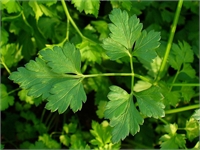
How to Plant Parsley in Your Vegetable Garden
Important Notice: Our web hosting provider recently started charging us for additional visits, which was unexpected. In response, we're seeking donations. Depending on the situation, we may explore different monetization options for our Community and Expert Contributors. It's crucial to provide more returns for their expertise and offer more Expert Validated Answers or AI Validated Answers. Learn more about our hosting issue here.

How to Plant Parsley in Your Vegetable Garden
You must be logged in to post a comment.
Cooking with fresh herbs can impart unmistakable flavor in your recipes. Parsley is a bright herb packed with nutrients. Related to the celery family, parsley is commonly available all year in supermarkets. If you want to grow your own, you can produce a successful parsley crop with a little bit of preparation and careful gardening.
Seed Preparation and Germination
Parsley seeds germinate slowly, so advanced planning is important for a successful growing season. When growing parsley, It can take two to five weeks for the seeds to germinate, with longer germination times being more likely for older seeds. You can increase your chances of success and cut germination time by soaking the seeds in warm water for as long as 24 hours before you plant them.
Start the seeds indoors with a well-draining soil and a pot that includes drainage holes at the bottom. Plant the seeds up to eight weeks before the last frost to ensure that the seedlings will be ready to transplant when the frost dangers pass and the soil warms up outside. Alternatively, you can sow the seeds directly in warm soil once the frost risk passes. Protect seeds by covering them with 1/8-inch of soil when planting. Keep the soil moist until you see seedlings sprout in two to three weeks.
Seedling Care
You can transplant seedlings started indoors after they reach a total height of at least two inches. Plant the seedlings in a well-draining soil, approximately eight to ten inches apart.
Direct-sow seedlings should be thinned out once they reach two to three inches high. Thin to the strongest seedlings, the ones with the leaves and stalks in the best condition. Leave the resulting plants spaced eight to ten inches apart, pulling everything in between.
Ensure that your seedlings receive full sun when you transplant them, but keep in mind that some shade daily is beneficial. Maintain an even water level in the soil without full saturation and layer the area with mulch to insulate the roots and retain moisture if needed.
Fertilize the area twice during the gardening season, at even intervals. Select a commercial fertilizer that is labeled 5-10-5, so that it is slightly higher in phosphorous than nitrogen or potassium. Spread 3 ounces of fertilizer for every 10-foot row. If your parsley is container-grown, use a liquid fertilizer once a month, but dilute it to half the strength called for on the package.
Seeding and Harvest
Parsley plants will be ready for harvest within 45 to 60 days from the time you transplant your seedlings. You can harvest stalks from parsley throughout the growing season, up until the first frost.
Harvest from the plant by trimming stalks with pruning shears. Cut near the base of the stalk to help encourage new growth. Prune the plant regularly, harvesting developed stalks that have not yet gone to seed. Dry parsley leaves on a drying rack or hang upside down in tied bunches. Grind the leaves or store them whole, keeping them in sealed, air-tight containers for up to a year.
Keep some parsley leaves without drying by packing them in freezer bags and laying them flat in the freezer for four to five hours, then storing them either flat or upright in the freezer for as much as one year from the preservation date. Parsley flavor thrives when it is fresh, but you may notice some intensity loss when you dry or freeze the leaves.
Parsley may reappear in spring if winter temperatures are not overly harsh. If this occurs, allow the plant to sprout flowering stalks and produce seeds. The stalks will produce seeds after the first productive year. If you allow the plant to return in the second year, the leaves may have a bitter flavor, indicative of aging parsley plants. You can plant fresh parsley every year to avoid this concern, allowing your plants to go to seed to help continue the crop.